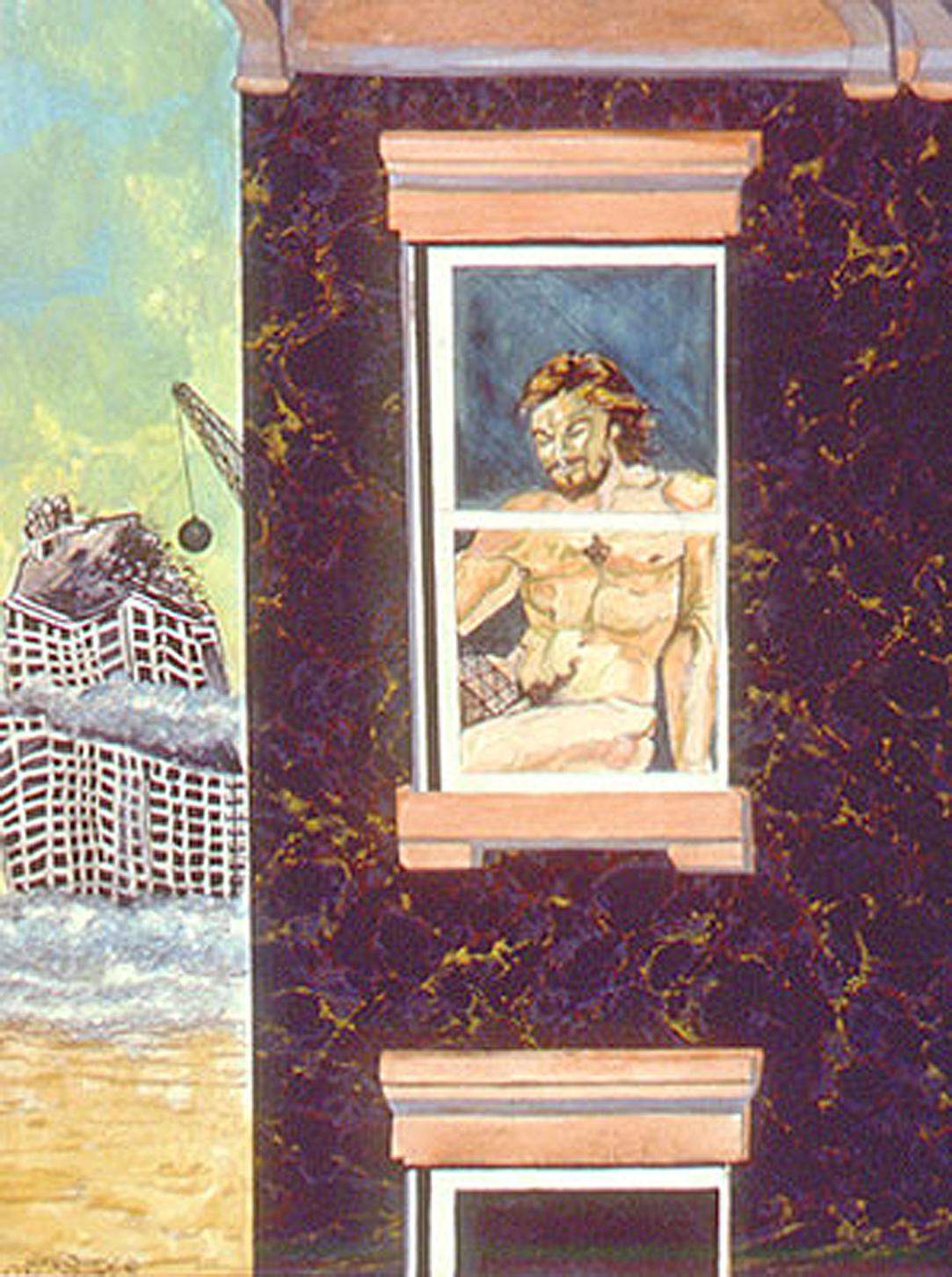The ART21 Magazine has teamed up with the nonprofit organization Visual AIDS to honor the twenty-fifth anniversary of Day With(out) Art and World AIDS Day 2014. Each month, Visual AIDS invites a guest curator, drawn from both the arts and AIDS communities, to organize an online gallery from the Visual AIDS Artist Registry. The Web Gallery increases exposure for artists living with HIV, keeps alive the work of those we have lost to AIDS, and continues the tradition of innovative collaborative work. We are pleased to co-present this month’s Web Gallery, curated by filmmaker Jim Hubbard, director of the feature-length documentary United in Anger: A History of ACT UP.
 December 1, 1989 was the first Day Without Art. Six hundred arts institutions participated. The Metropolitan Museum of Art removed Picasso’s Portrait of Gertrude Stein (still, a very odd choice). The Museum of Modern Art had Leonard Bernstein compose and play a two-minute piece. According to The New York Times:
December 1, 1989 was the first Day Without Art. Six hundred arts institutions participated. The Metropolitan Museum of Art removed Picasso’s Portrait of Gertrude Stein (still, a very odd choice). The Museum of Modern Art had Leonard Bernstein compose and play a two-minute piece. According to The New York Times:
“The loosely coordinated events—including gallery closings, the temporary removal of artworks from gallery walls, memorial services, performances and educational programs about AIDS—were organized by a group of arts professionals called Visual AIDS. The nationwide observance, which was held on the World Health Organization’s second AIDS Awareness Day and is to be an annual event, was called ‘to make people pay attention to the effects of AIDS on the art world and our society,’ said Thomas W. Sokolowski, a member of Visual AIDS.”
In retrospect, December 1989 seems a watershed moment, signaling, in some way, that the straight world—the world that had previously ignored the 117,508 US cases of AIDS and 89,343 deaths—now had to pay attention.
Not only did those six hundred largely mainstream institutions participate in the Day Without Art, nine days after Day Without Art the groups ACT UP and WHAM! organized the Stop the Church demonstration for which seven thousand people gathered outside of St. Patrick’s Cathedral in New York to protest John Cardinal O’Connor’s homophobic and misogynistic AIDS and anti-abortion policies. About one hundred fifty people demonstrated inside the cathedral, interrupting the Mass. A former altar boy spontaneously crumbled the Host and threw it to the floor. That “sacrilegious” action served as an excuse for the expression of intense ire around the world. At the same time, the action demonstrated the strength and determination of AIDS activists and utterly changed the western world’s perception of gay people.
This Visual AIDS Web Gallery largely consists of works produced by artists who died in 1989 or shortly thereafter, or artists who were making work in 1989. Many people died of AIDS throughout the ’80s and ’90s but AIDS didn’t just end lives; it destroyed a burgeoning culture of public gayness and a flourishing artistic expression of unbridled sexuality.
Ed Aulerich-Sugai (1959–1994)

Ed Aulerich-Sugai. Angry Anger, 1991. Diptych, mixed media on paper; 44 1/4 x 22 1/4 inches. Courtesy the Estate of Ed Aulerich-Sugai and Visual AIDS.
Anger was a dominant emotion in 1989, so this piece seemed an appropriate place to begin.
Ray Navarro (1964–1990)
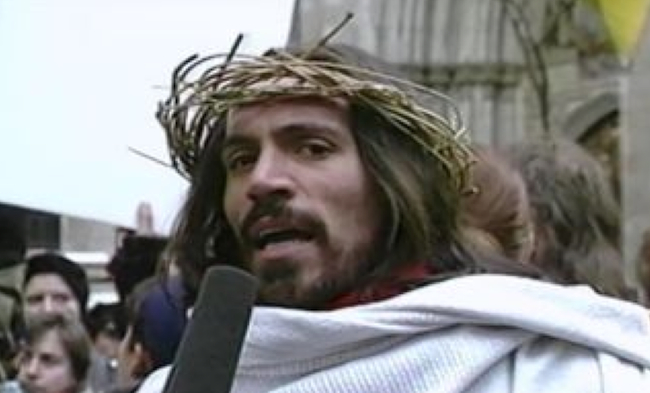
Ray Navarro. Untitled video still from DIVA TV’s Like a Prayer, from Stop The Church action, 1989. Courtesy Visual AIDS.
Ray was a great presence in ACT UP, the AIDS activist group. The first time I met him, I felt that I had known him my entire life. He exuded that kind of warmth and human connection. He had a great sense of political theater, a wonderful eye, and a mischievous smile that lit up the universe.
Marc Lida (1957–1992)
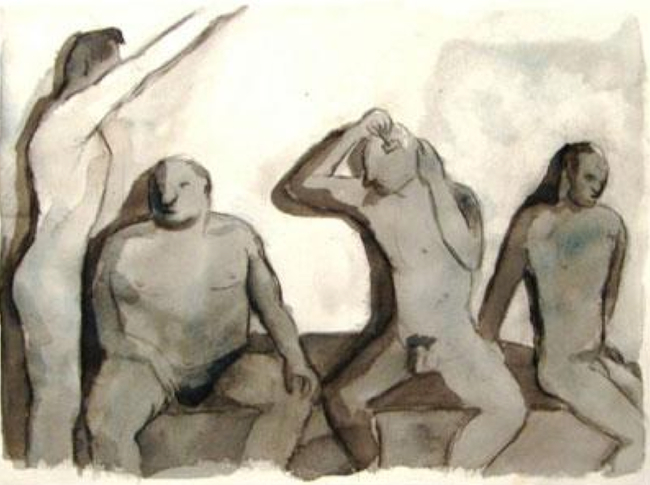
Marc Lida. Steamroom, 1979. Ink washes on paper; 12 x 16 inches. Courtesy the Estate of Marc Lida and Visual AIDS.
I loved the baths and they were an integral part of the gay experience in the ’70s and ’80s. I loved the sense of adventure and the hunt. I loved being with so many naked men’s bodies. I loved the connections and the closeness and the tension. I think I even loved the rejection—sometimes.
Vincent Cianni (1952–)

Vincent Cianni. Christopher Street Pier, NYC, 1989. Gelatin silver print; 16 x 20 inches. Courtesy the artist and Visual AIDS.
This picture of the Christopher Street Pier was taken in 1989. The feeling of community, of being different, of getting away with something, the feeling you might fall through a hole into the river—all that has been surgically removed from the gentrified, prettified, and pristine version of the piers we have now.
Bern Boyle (1951–1992)

Bern Boyle. Portrait of Michael Wilson, 1989. Postcard; 4×6. Courtesy Visual AIDS.
I didn’t know Michael Wilson (1952–1996), but I would see him walking around the East Village all the time. He was the personification of leading a life exactly as you wanted.
Hunter Reynolds (1959–)

Hunter Reynolds. Stop the Church, 1989. Courtesy the artist and Visual AIDS.
Hunter getting arrested at Stop the Church on December 10, 1989, protesting the evil John Cardinal O’Connor who gay bashed while he collected money from people with AIDS in his Catholic hospitals. He pretended to be righteous but was an evil son of a bitch.
Howard Brookner (1954–1989)

Howard Brookner. Untitled, c. 1973. Acrylic; dimensions unknown. Courtesy Visual AIDS.
Howard was a filmmaker so this painting is really a stand-in for a moving image. He made Burroughs: The Movie, a great film about William Burroughs.
Adrian Kellard (1959–1991)
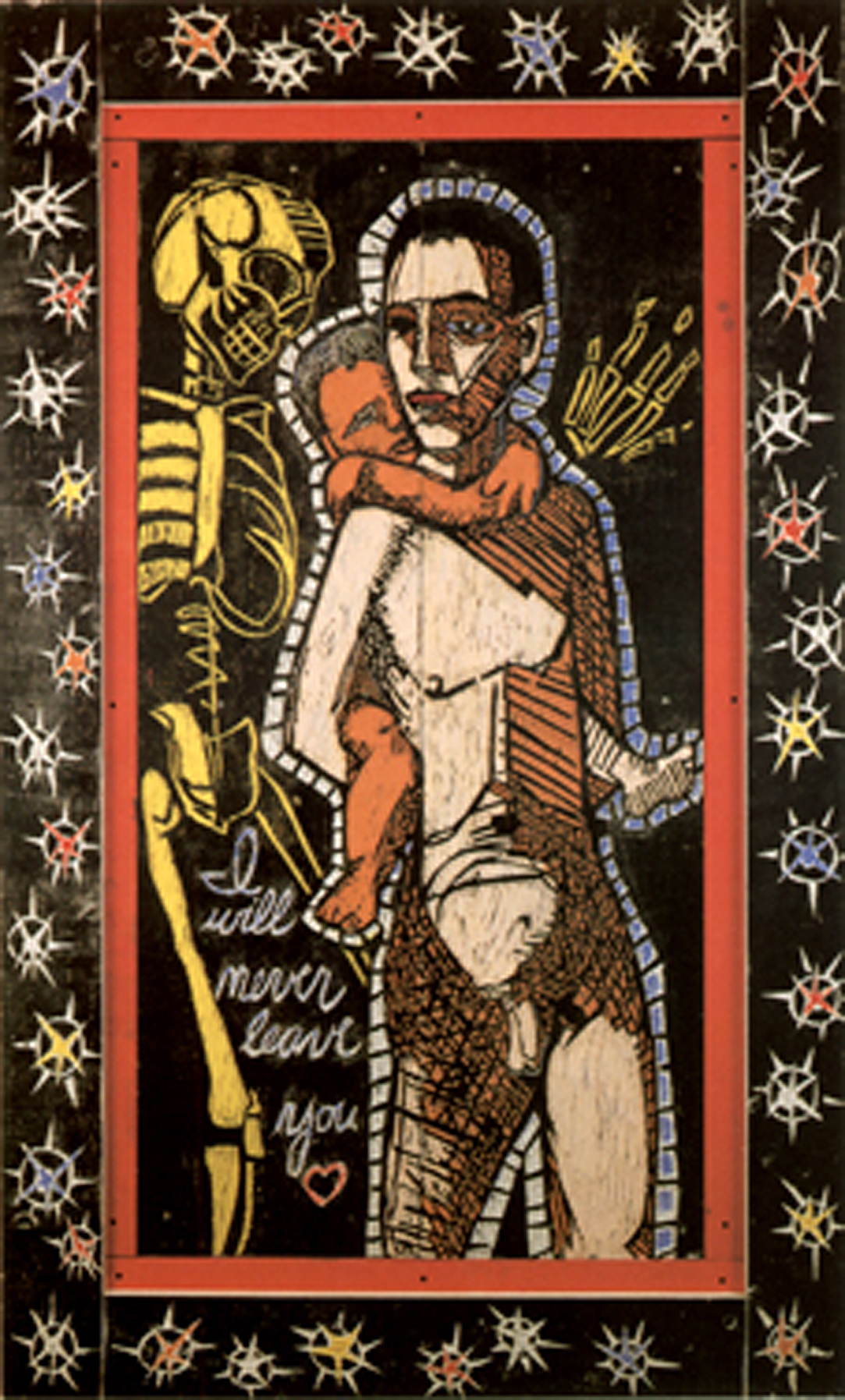
Adrian Kellard. The Promise, 1989. Latex on wood; dimensions unknown. Courtesy the Estate of Adrian Kellard and Visual AIDS.
I suppose this painting is intended as a reference to St. Christopher, which is just a dyslexic form of Christopher Street. I mostly respond to the skeleton that promises, “I will never leave you.”
Carlos Almaraz (1941–1989)

Carlos Almaraz. Grid in Blue, 1989. Oil on canvas; 36 x 48 inches. Courtesy of the Estate of Carlos Almaraz and Visual AIDS.
This Web Gallery is very New York-centric, so I thought I should include some West Coast work. What delights me in this painting are the exuberant, very California colors and everything crashing into everything else.
Greg Maskwa (1953–)
The naked man juxtaposed with the wrecking ball destroying a building evokes two overwhelming aspects of 1989: Lives and buildings both were crumbling in 1989.
I don’t believe we are all voyeurs, but there is something wonderful about the unexpected view of a naked man in a window. One summer night some years ago, Nelson Gonzalez and I were walking down Broadway when we spied a man taking a shower about eight flights up. We stood and watched for twenty minutes as he repeatedly soaped up and rinsed his penis and his asshole for what we could only imagine was going to be a very hot date.
Jack Smith (1932–1989)
Jack Smith pioneered performance art and made a crazy, queer kind of film and collage art that featured a mad mishmash of weird politics and sexual anarchy. (Although featured here, Smith’s film Normal Love is not included in the Visual AIDS Artist Registry.)
David Wojnarowicz (1954–1992)

David Wojnarowicz. Abandoned Warehouse, 1983. Paint on wall/piers; site=specific installation. Courtesy the Estate of David Wojnarowicz and P.P.O.W., New York.
In the 1980s, artists could break into disused New York City piers and create huge, inspiring spur-of-the-moment exhibitions.
Keith Haring (1958–1990)

Keith Haring. Once Upon a Time mural, LGBT Center, NYC, 1989. Keith Haring artwork © Keith Haring Foundation, LGBT Center, NYC. Courtesy the Keith Haring Foundation and Visual AIDS.
Also, in the 1980s artists could create manic, excessive, hot murals in community center bathrooms. Let’s not forget that New York City’s LGBT Community Center had to be forced not to destroy this one.
Scott Burton (1939–1989)
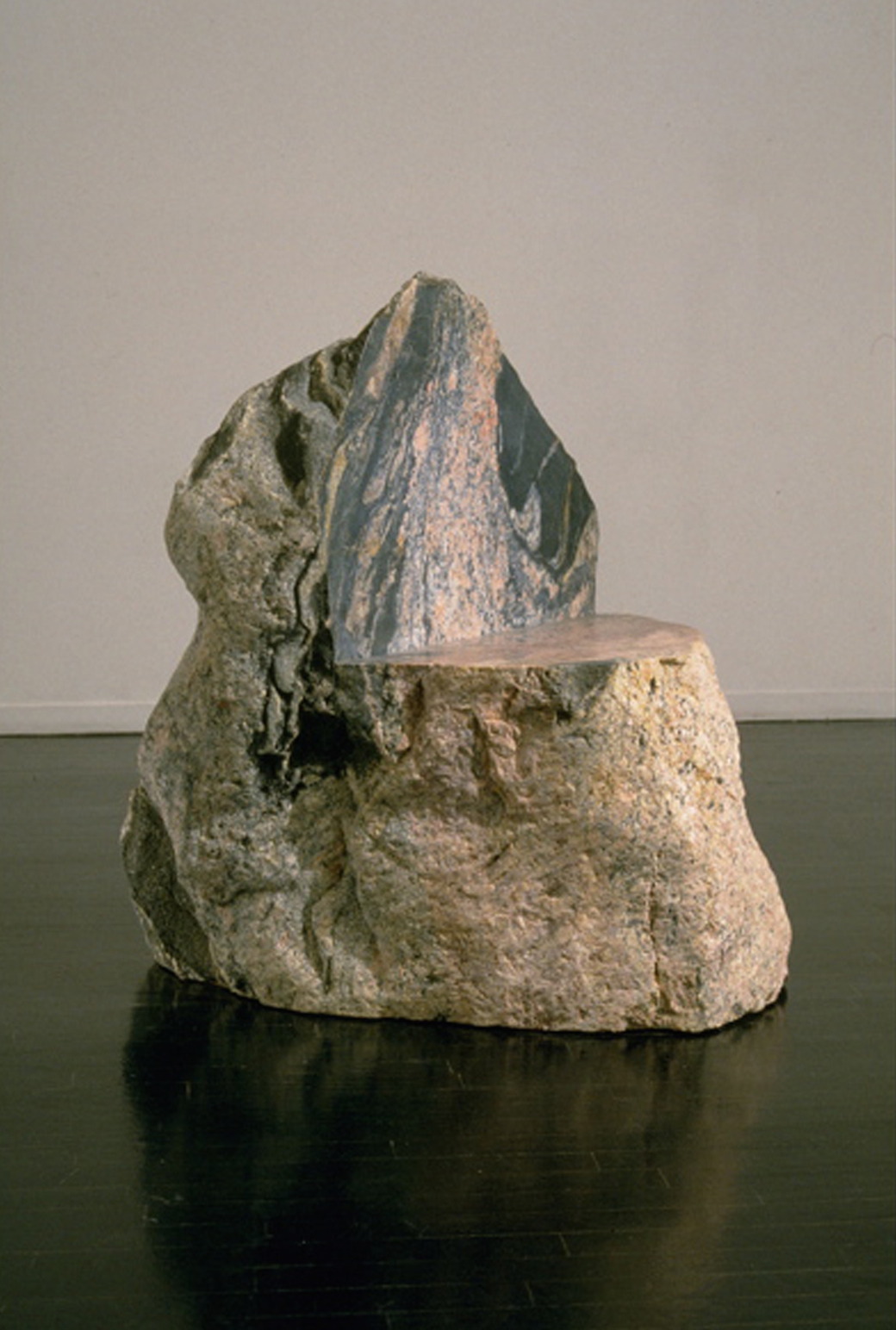
Scott Burton. Rock Chair #14, 1989. Rainbow granite; 40 x 30 1/2 x 32 inches. Courtesy the Estate of Scott Burton. Courtesy Visual AIDS.
My favorite Scott Burton chairs are outside the Equitable Life Insurance Co. on Seventh Avenue. They’re cold and hard and incredibly uncomfortable. Perfect for captains of industry to spend eternal life on.
Rotimi Fani-Kayode (1955–1989)
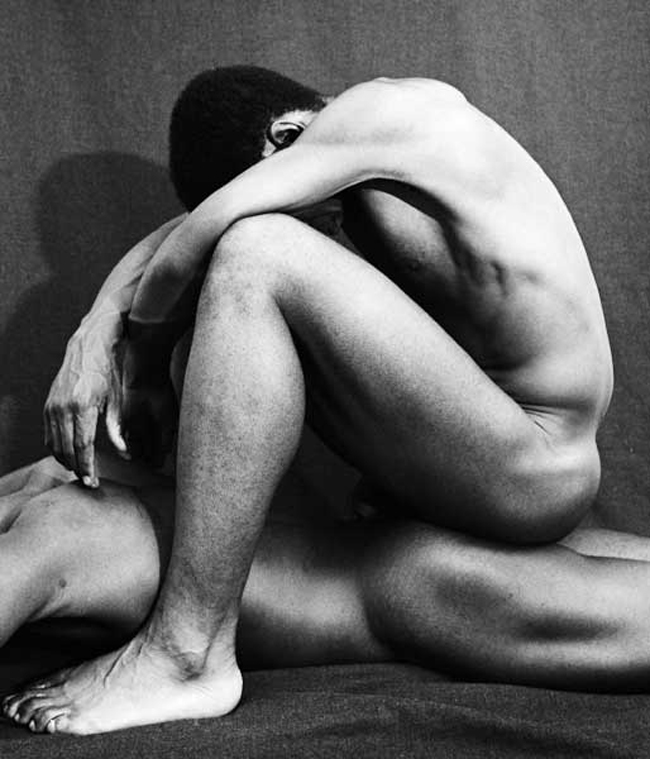
Rotimi Fani-Kayodé. Techniques of Ecstasy No. 4, 1987. Silver gelatin print; 19 x 16.5 inches, edition of 10. Courtesy Visual AIDS.
Sometimes I’m afraid that his work is a bit too self-consciously exotic—but this is a lovely, mysterious photograph. Is it after sex, or before, or just a comfortable place to sit?
Robert Mapplethorpe (1946–1989)

Robert Mapplethorpe. Self Portrait, 1975. Gelatin silver print. Courtesy the Estate of Robert Mapplethorpe and Visual AIDS.
Mapplethorpe at his diabolical loveliest. I thought maybe this photograph was taken before he had his nipple pierced, but then I realized it was the other nipple.
Mark Morrisroe (1959–1989)
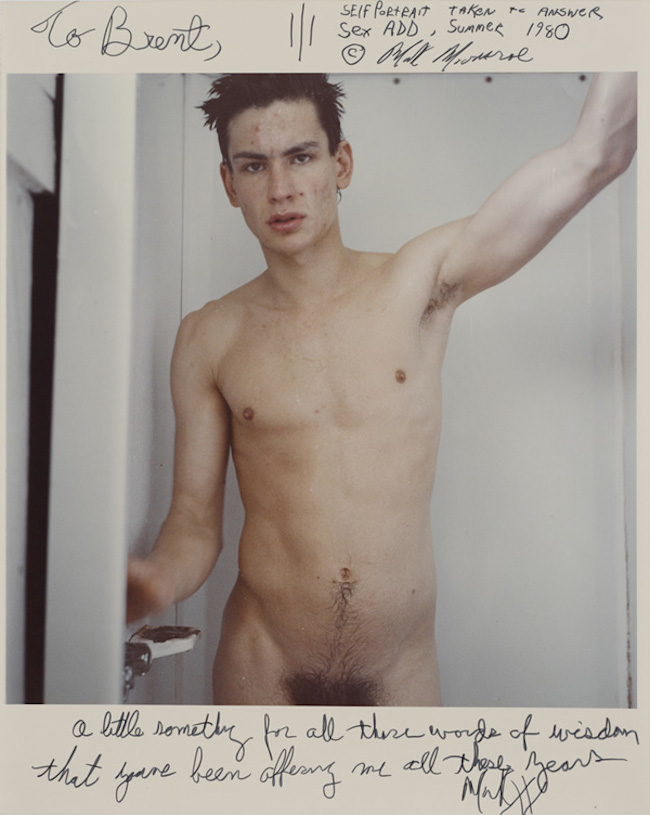
Mark Morrisroe. Self Portrait (to Brent), 1982. C-print, negative sandwich, retouched with ink and marker; 20 x 16 inches. Collection: Brent Sikkema. Courtesy Visual AIDS. © The Estate of Mark Morrisroe
Pimply-faced, lithesome Mark Morrisroe in 1982 and then unabashed and unapologetic in 1989.
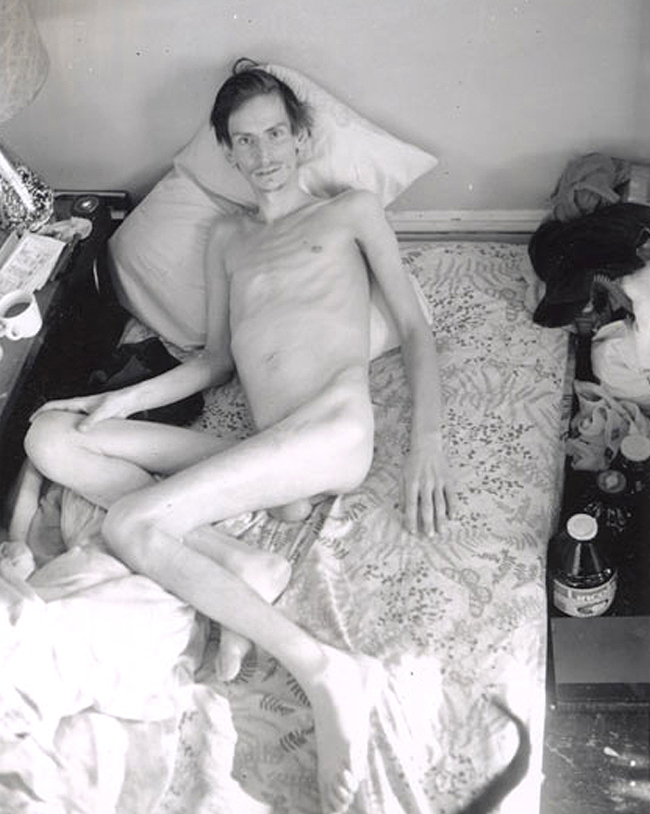
Mark Morrisroe. Self Portrait, 1989. T-665 Polaroid; 4 1/4 x 3 1/2 inches. Courtesy the Estate of Mark Morrisroe (Ringier Collection) at Fotomuseum Winterthur and Visual AIDS. © The Estate of Mark Morrisroe
David Wojnarowicz (1954–1992)
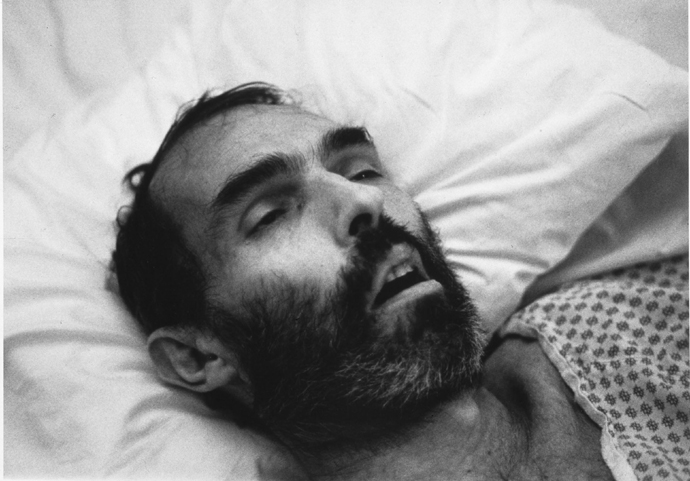
David Wojnarowicz. Untitled (Peter Hujar), 1989. Gelatin silver print; 10 x 14 inches. Courtesy the estate of David Wojnarowicz, P.P.O.W., New York, and Visual AIDS.
The year 1989 was a time when people photographed their dead lovers. It was a way to remember them and to make explicit the awful toll the epidemic extracted from us.
For the 25th anniversary of Day With(out) Art, Visual AIDS has organized Alternate Endings, a new video program featuring works by Rhys Ernst, Glen Fogel, Lyle Ashton Harris, Derek Jackson, Tom Kalin, My Barbarian, and Julie Tolentino. Screenings take place today in the United States and abroad; visit www.visualaids.org for the schedule of events.

